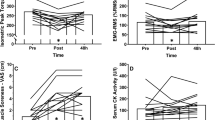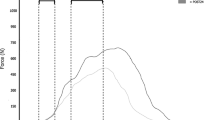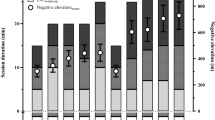Abstract
Purpose
This study examined whether lower-volume exercise-induced muscle damage (EIMD) performed 2 weeks before high-volume muscle-damaging exercise protects against its detrimental effect on running performance.
Methods
Sixteen male participants were randomly assigned to a lower-volume (five sets of ten squats, n = 8) or high-volume (ten sets of ten squats, n = 8) EIMD group and completed baseline measurements for muscle soreness, knee extensor torque, creatine kinase (CK), a 5-min fixed-intensity running bout and a 3-km running time-trial. Measurements were repeated 24 and 48 h after EIMD, and the running time-trial after 48 h. Two weeks later, both groups repeated the baseline measurements, ten sets of ten squats and the same follow-up testing (Bout 2).
Results
Data analysis revealed increases in muscle soreness and CK and decreases in knee extensor torque 24–48 h after the initial bouts of EIMD. Increases in oxygen uptake \( \left( {{\dot{V}\text{O}}_{2} } \right) \), minute ventilation \( \left( {{\dot{V}}_{\text{E}} } \right) \) and rating of perceived exertion were observed during fixed-intensity running 24–48 h after EIMD Bout 1. Likewise, time increased and speed and \( {\dot{V}\text{O}}_{ 2} \) decreased during a 3-km running time-trial 48 h after EIMD. Symptoms of EIMD, responses during fixed-intensity and running time-trial were attenuated in the days after the repeated bout of high-volume EIMD performed 2 weeks after the initial bout.
Conclusions
This study demonstrates that the protective effect of lower-volume EIMD on subsequent high-volume EIMD is transferable to endurance running. Furthermore, time-trial performance was found to be preserved after a repeated bout of EIMD.



Similar content being viewed by others
Abbreviations
- CK:
-
Creatine kinase
- CO2 :
-
Carbon dioxide
- EIMD:
-
Exercise-induced muscle damage
- EMG:
-
Electromyography
- HR:
-
Heart rate
- [La]:
-
Blood lactate
- LTP:
-
Lactate turnpoint
- MVC:
-
Maximal voluntary contraction
- O2 :
-
Oxygen
- RBE:
-
Repeated bout effect
- RPE:
-
Rating of perceived exertion
- SF:
-
Stride frequency
- SL:
-
Stride length
- VAS:
-
Visual analogue scale
- \( {\dot{V}}_{\text{E}} \) :
-
Minute ventilation
- \( {\dot{V}\text{O}}_{ 2} \) :
-
Oxygen uptake
- VL:
-
Vastus lateralis
- VM:
-
Vastus medialis
- \( {\dot{V}\text{O}}_{{ 2 {\text{peak}}}} \) :
-
Peak oxygen uptake
References
Ansley L, Schabort E, St Clair Gibson A, Lambert MI, Noakes TD (2004) Regulation of pacing strategies during successive 4-km time trials. Med Sci Sports Exerc 36:1819–1825
Armstrong RB, Laughlin MH, Rome L, Taylor CR (1983) Metabolism of rats running up and down an incline. J Appl Physiol 55:518–521
Bigland-Ritchie B, Woods JJ (1974) Integrated EMG and oxygen uptake during dynamic contractions of human muscles. J Appl Physiol 36:475–479
Borg G (1998) Borg’s perceived exertion and pain scales. Human Kinetics, Champaign
Braun WA, Dutto DJ (2003) The effects of a single bout of downhill running and ensuing delayed onset of muscle soreness on running economy performed 48 h later. Eur J Appl Physiol 90:29–34
Brown SJ, Child RB, Day SH, Donnelly AE (1997) Exercise-induced skeletal muscle damage and adaptation following repeated bouts of eccentric muscle contractions. J Sports Sci 15:215–222
Burt DG, Twist C (2011) The effects of exercise-induced muscle damage in time-trial cycling performance. J Strength Cond Res 25:2185–2192
Burt D, Lamb K, Nicholas C, Twist C (2013) Effects of repeated bouts of squatting exercise on sub-maximal endurance running performance. Eur J Appl Physiol 113:285–293
Byrne C, Eston RG, Edwards RHT (2001) Characteristics of isometric and dynamic strength loss following eccentric exercise-induced muscle damage. Scand J Med Sci Sports 11:134–140
Byrnes WC, Clarkson PM, White JS, Hsieh SS, Frykman PN, Maughan RJ (1985) Delayed onset of muscle soreness following repeated bouts of downhill running. J Appl Physiol 59:710–715
Chen TC (2003) Effects of a second bout of maximal eccentric exercise on muscle damage and electromyographic activity. Eur J Appl Physiol 89:115–121
Chen TC, Nosaka K, Lin M, Chen N, Wu C (2009) Changes in running economy at different intensities following downhill running. J Sports Sci 27:1137–1144
Clarkson PM, Tremblay I (1988) Exercise-induced muscle damage, repair, and adaptation in humans. J Appl Physiol 65:1–6
Currell K, Jeukendrup AE (2008) Validity, reliability, and sensitivity of measures of sporting performance. Sports Med 38:297–316
Davies RC, Rowlands AV, Eston RG (2009) Effect of exercise-induced muscle damage on ventilatory and perceived exertion responses to moderate and severe intensity cycle exercise. Eur J Appl Physiol 107:11–19
Hermens HJ, Freriks B, Merletti R, Stegeman D, Blok J, Rau G, Disselhorst-Klug C, Hagg G (1999) SENIAM 8: European recommendations for surface electromyography. Roessingh Research and Development, Enschede
Hortobagyi T, Houmard J, Fraser D, Dudek R, Lambert J, Tracy J (1998) Normal forces and myofibrillar disruption after repeated eccentric exercise. J Appl Physiol 84:492–498
Howatson G, van Someren K, Hortobagyi T (2007) Repeated bout effect after maximal eccentric exercise. Int J Sports Med 28:557–563
Hubal MJ, Devaney JM, Hoffman EP, Zambraski EJ, Gordish-Dressman H, Kearns AK, Larkin JS, Adham K, Patel RR, Clarkson PM (2010) CCL2 and CCR2 polymorphisms are associate with markers of exercise-induced skeletal muscle damage. J Appl Physiol 108:1651–1658
Jameson C, Ring C (2000) Contributions of local and central sensations to the perception of exertion during cycling: effects of work rate and cadence. J Sports Sci 18:291–298
Jones AM, Vanhatalo AT, Doust JH (2009) Aerobic exercise performance. In: Eston RG, Reilly T (eds) Kinanthropometry and exercise physiology laboratory manual: tests, procedures and data: volume 2: physiology. Routledge, United Kingdom
Konrad P (2005) The ABC of EMG: A practical introduction to kinesiological electromyography. Noraxon Inc, Scottsdale
Kupa EJ, Roy SH, Kandarian SC, De Luca CJ (1995) Effects of muscle fibre type and size on EMG median frequency and conduction velocity. J Appl Physiol 79:23–32
Kyröläinen H, Pullinen T, Candau R, Avela J, Huttunen P, Komi PV (2000) Effects of marathon running on running economy and kinematics. Eur J Appl Physiol 82:297–304
Marcora S (2009) Perception of effort during exercise is independent of afferent feedback from skeletal muscles, heart and lungs. J Appl Physiol 106:2060–2062
Marcora SM, Bosio A (2007) Effect of exercise-induced muscle damage on endurance running performance in humans. Scand J Med Sci Sports 17:662–671
McHugh MP (2003) Recent advances in the understanding of the repeated bout effect: the protective effect against muscle damage from a single bout of eccentric exercise. Scand J Med Sci Sports 13:88–97
McHugh MP, Connolly DAJ, Eston RG, Gleim GW (1999) Exercise-induced muscle damage and potential mechanisms for the repeated bout effect. Sports Med 27:157–170
Nosaka K, Sakamoto K, Newton M, Sacco P (2001) The repeated bout effect of reduced-load eccentric exercise on elbow flexor muscle damage. Eur J Appl Physiol 85:34–40
Price DD, McGrath PA, Rafii A, Buckingham B (1983) The validation of visual analogue scales as ratio scale measures for chronic and experimental pain. Pain 17:45–56
Twist C, Eston R (2009) The effect of exercise-induced muscle damage on perceived exertion and cycling performance. Eur J Appl Physiol 105:559–567
Acknowledgments
The authors wish to thank all participants who took part in the study and the Human Performance Laboratory staff for their technical support.
Conflict of interest
The authors declare that they have no conflict of interest.
Ethical standard
The authors declare that the experiments carried out complied with current UK laws.
Author information
Authors and Affiliations
Corresponding author
Additional information
Communicated by Martin Flueck.
Rights and permissions
About this article
Cite this article
Burt, D., Lamb, K., Nicholas, C. et al. Lower-volume muscle-damaging exercise protects against high-volume muscle-damaging exercise and the detrimental effects on endurance performance. Eur J Appl Physiol 115, 1523–1532 (2015). https://doi.org/10.1007/s00421-015-3131-y
Received:
Accepted:
Published:
Issue Date:
DOI: https://doi.org/10.1007/s00421-015-3131-y




